ASUS MS238H Review - Slim and Affordable
by Brian Klug on December 24, 2010 1:47 AM ESTViewing Angles
First up in our objective analysis are viewing angles. We're on a TN panel here and thus shouldn't expect much in the way of excellent viewing angles, however the MS238H actually performs very well, potentially thanks in part to WLED backlighting. ASUS advertises 170 degrees horizontal and 160 degrees vertical with a 10:1 contrast ratio. That's a bit low of a cutoff contrast ratio for viewing angle consideration, but in the horizontal direction the MS238H performs very well.
Vertically we see what we're used to with TN panels and get serious color distortion when viewed from extreme angles below the display, but not much when we view it from extreme angles above.
Color Gamut
Next up are the ever-important color quality metrics. As usual, we report two main quality metrics: color accuracy (Delta-E) and color gamut. Color gamut refers to the range of colors the display is able to represent with respect to some color space. In this case, our reference is the AdobeRGB 1998 color space, which is larger than the sRGB color space. Our percentages are thus reported with respect to AdobeRGB 1998, and larger is generally better unless you're dealing with sRGB content and colorspace-unaware software.
Color accuracy (Delta E) refers to the display’s ability to display the correct color requested by the GPU and OS. The difference between the color represented by the display, and the color requested by the GPU is our Delta-E, and lower is better here. In practice, a Delta E under 1.0 is perfect - the chromatic sensitivity of the human eye is not great enough to distinguish a difference. Moving up, a Delta E of 2.0 or less is generally considered fit for use in a professional imaging environment - it isn’t perfect, but it’s hard to gauge the difference. Finally, Delta E of 4.0 and above is considered visible with the human eye. Of course, the big consideration here is frame of reference; unless you have another monitor or some print samples like a Gretag Macbeth color checker card to compare your display with, you might not notice.
As I mentioned in our earlier reviews, we’ve updated our display test bench. We’ve deprecated the Monaco Optix XR Pro colorimeter in favor of an Xrite i1D2 since there are no longer up-to-date drivers for modern platforms.
For these tests, we calibrate the display and try to obtain the best Delta-E we can get at both 200 nits of brightness for normal use, and 100 nits for print brightness. We target D65 and a gamma of 2.2, but sometimes the best performance lies at native temperature and another gamma, so we try to find what absolute absolute best-case performance for each display. We also take an uncalibrated measurement to show performance out of the box using either the manufacturer supplied color profile, or a generic one with no LUT data. For all of these, dynamic contrast is disabled, and displays are left to settle for a half hour after making changes. Of course, the MS238H is LED backlit so settling time is essentially instantaneous, as compared to CCFLs that often take a half hour or more to settle.
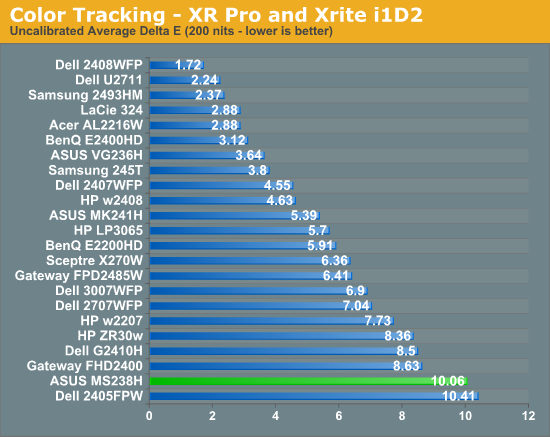

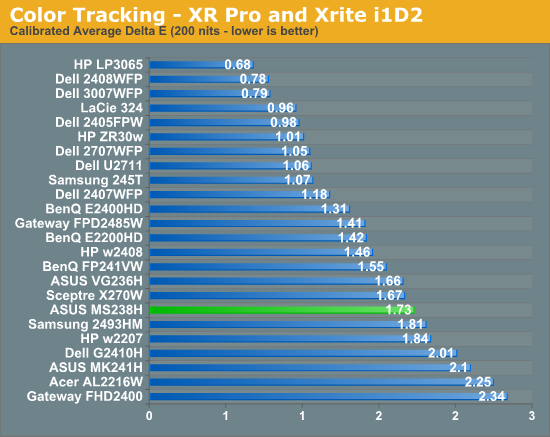
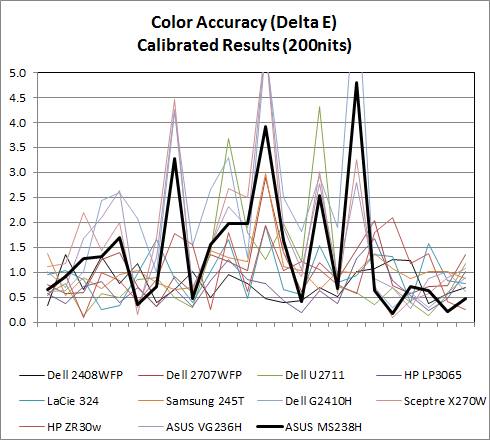
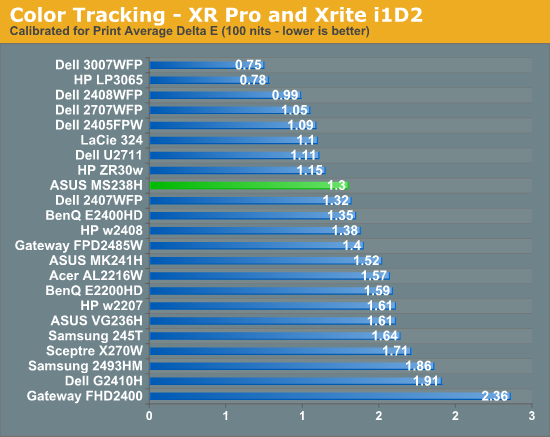
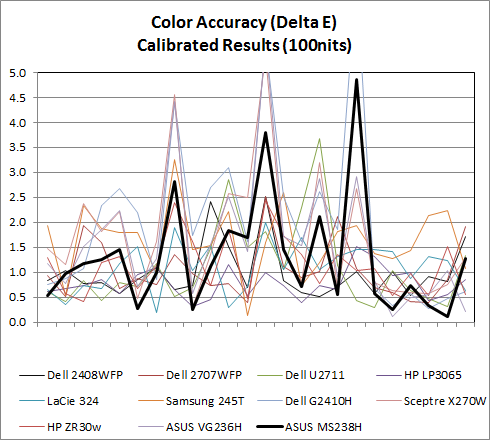
Uncalibrated and set to 200 nits, the MS238H is among the worst we've seen. Out of the box, the display is noticeably blueish. Initial measurements put white point around 7300K. After tweaking the RGB controls to nail D65, 200 nits, and a few calibration tweaks later, the MS238H actually performs pretty decent, with a Delta-E of 1.73. It's nothing stellar, but not bad considering our comparison is chock-full of IPS panels. Performance improves a bit at 100 nits, moving the MS238H almost up into IPS territory.
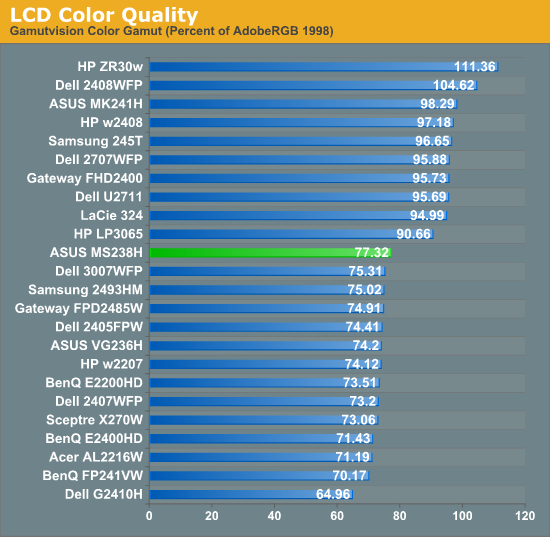
When it comes to gamut, the MS238H actually leads our stairstep-pattern of display results. Gamut could be better if the MS238H had RGB LED backlighting instead of WLED, but again this is a budget monitor with slim profile and power-sipping priorities.








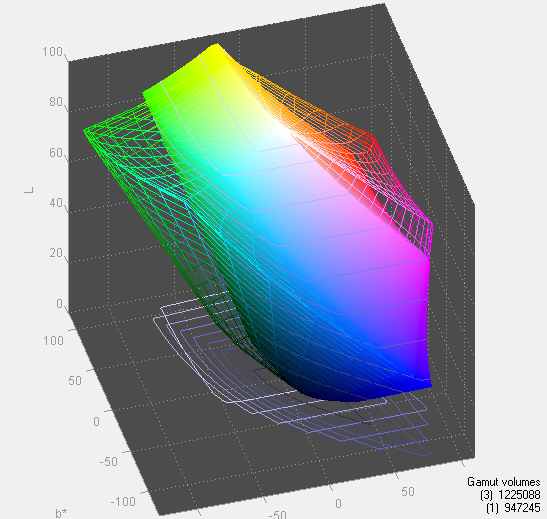








38 Comments
View All Comments
Brian Klug - Friday, December 24, 2010 - link
Oops, fixed! We switched graphing engines and two entries always had their series reversed, didn't catch that one.-Brian
Spacecomber - Friday, December 24, 2010 - link
Numbers are reversed.dingetje - Friday, December 24, 2010 - link
asus can shove their 16:9 displays where the sun don't shine :)bring back 16:10
chrnochime - Friday, December 24, 2010 - link
And you can do the same with your oh- so-very-useful comment :Djah1subs - Friday, December 24, 2010 - link
ONE or TWO YEARS AGO, I remember reading in Digitimes that panel makers were going to be transitioning from 16:10 to 16:9 because they could cut out more panels per "substrate" or "wafer" or whatever it is called.So yes, it is about manufacturing cost. I just saw an article on Digitimes yesterday that some manufacturers will be starting to manufacture, or plan to manufacture, even more extreme aspect ratios, e.g. 21:9.
Conclusion, IMHO, if you see a 16:10 that you like today, buy it. There might not be a next generation version of it.
Personally, I am starting to be interested in 16:9 27" LED backlit monitors. The first ones have recently come on the market. I make this statement based on using Newegg's PowerSearch function. Until recently, 24" were listed but not 27". These monitors are the smallest size that will allow me to display images of 2 views of 8.5x11 paper at 100% scale in portrait mode side by side. Of course, I want LED for reduced power requirements and improved contrast.
Sundae - Friday, December 24, 2010 - link
Hey any chance of you guys doing a review on the Samsung P2370? I ask because I was strongly considering this monitor but heard the P2370 was a better choice. It even came with a microfiber cloth!poohbear - Saturday, December 25, 2010 - link
erm how many of the andandtech reviews start with "so i have a confession to make." lol scrolling down the nvidia tegra 2 article starts the same. just a get a priest on the andandtech staff already to absolve u of your hardware lusting sins.Hrel - Saturday, December 25, 2010 - link
I really hate how it seems like everyone at anadtech is against 1080p. That's the industry standard, that's where things are going, quite fighting it and get with the times. 16:9 is a great divide between height and width. Also, all modern content is made for 16:9, NOT 16:10. Black bars are FUCKING ANNOYING!Second point, all movies that are filmed in anything wider than 16:9 are stupid and I end up cropping them in Power Director. I long for the day when ALL media content is just standardized at 16:9 with no variation at all. That way everything would fit the screen and nothing would need to be formatted there by wasting valuable screen real estate.
Hrel - Saturday, December 25, 2010 - link
I should add that every monitor should have a base that allows for it to be spun so it's wider than it is tall. I do understand there are times when massive vertical real estate is nice. I use a 37" TV as my monitor so I have no issues. But on a smaller screen it'd be nice to be able to spin it and have the screen know that like smart phones do.wagoo - Sunday, December 26, 2010 - link
You have no issues with vertical real estate because you use a 37" TV as your monitor? Um.. it'll still have the same 1080 pixels available as a 22" 1080p monitor.. or hey, slightly more than my ancient 17" 1280x1024 LCD.A lot of the TN panels if you look at them from a vertical orientation you'll get a headache unfortunately, as each eye will be seeing different colours.
I prefer 16:10 personally, however I think that's mainly due to 1080p just being too small height-wise. Maybe I'd like the 2560x1440 Dell U2711.